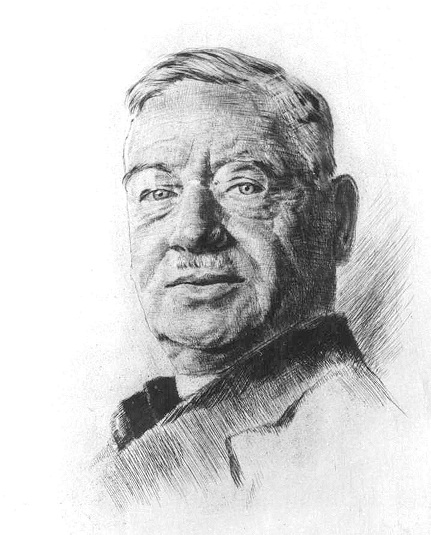<Back to Index>
- Pharmacologist Otto Loewi, 1873
- Painter Johan Barthold Jongkind, 1819
- King of the United Kingdom George V, 1865
PAGE SPONSOR

Otto Loewi (June 3, 1873 – December 25, 1961) was a German pharmacologist whose discovery of acetylcholine helped enhance medical therapy. The discovery earned for him the Nobel Prize in Physiology or Medicine in 1936 which he shared with Sir Henry Dale. He has been referred to as the "Father of Neuroscience."
Loewi was born in Frankfurt, Germany. He received his medical doctoral degree from University of Strasbourg (then part of Germany) in 1896, where he also was a member of the fraternity Burschenschaft Germania Strassburg. During 1897 - 1898 he was assistant to Carl von Noorden, clinician at the City Hospital in Frankfurt. Soon, however, after seeing the high mortality in countless cases of far-advanced tuberculosis and pneumonia, left without any treatment because of lack of therapy, he decided to drop his intention to become a clinician and instead to carry out research in basic medical science, in particular pharmacology. In 1898 he succeeded in becoming an assistant of Professor Hans Horst Meyer, the renowned pharmacologist at the University of Marburg, from 1904 Professor of Pharmacology in Vienna. In 1905 Loewi became Associate Professor at Meyer's laboratory, and in 1909 he was appointed to the Chair of Pharmacology in Graz.
During his first years in Marburg, Loewi's studies were in the field of metabolism. As a result of his work on the action of phlorhizin, a glucoside provoking glycosuria, and another one on nuclein metabolism in man, he was appointed "Privatdozent" (Lecturer) in 1900. Two years later he published his paper "Über Eiweisssynthese im Tierkörper" (On protein synthesis in the animal body), proving that animals are able to rebuild their proteins from their degradation products, the amino acids - an essential discovery with regard to nutrition. Loewi investigated how vital organs respond to chemical and electrical stimulation. He also established their relative dependence on epinephrine for proper function. Consequently, he learnt how nerve impulses are transmitted by chemical messengers. The first chemical neurotransmitter that he identified was acetylcholine.
In 1903, he accepted an appointment at the University of Graz in Austria, where he would remain until being forced out of the country in 1938. In 1905 he received Austrian citizenship.
He married Guida Goldschmiedt in 1908. They had three sons and a daughter. He was the last Jew hired by the University between 1903 and the end of the war.
After being arrested, along with two of his sons, on the night of the German invasion of Austria, March 11, 1938, Loewi was released on condition that he "voluntarily" relinquish all his possessions to the Nazis. Loewi moved to the United States in 1940, where he became a research professor at the New York University College of Medicine. In 1946, he became a naturalized citizen of the United States. In 1954, he became a Foreign Member of the Royal Society. He died in New York City on December 25, 1961.
Shortly after Loewi's death in late 1961, his youngest son bestowed the gold Nobel medal on the Royal Society in London. He gave the Nobel diploma to the University of Graz in Austria in 1983, where it currently resides, along with a bronze copy of a bust of Loewi. The original of the bust is at the Marine Biological Laboratory in Woods Hole, Massachusetts, Loewi's summer home from his arrival in the US until his death. Before Loewi's experiments, it was unclear whether signalling across the synapse was bioelectrical or chemical.
Loewi's famous experiment, published in 1921, largely answered this
question. According to Loewi, the idea for his key experiment came to
him in his sleep. He dissected out of frogs two beating hearts: one with the vagus nerve which
controls heart rate attached, the other heart on its own. Both hearts
were bathed in a saline solution (i.e. Ringer's solution). By
electrically stimulating the vagus nerve, Loewi made the first heart
beat slower. Then, Loewi took some of the liquid bathing the first
heart and applied it to the second heart. The application of the liquid
made the second heart also beat slower, proving that some soluble
chemical released by the vagus nerve was controlling the heart rate. He
called the unknown chemical Vagusstoff. It was later found that this chemical corresponded to acetylcholine (Kandel, et al. 2000). Loewi's
investigations “On an augmentation of adrenaline release by cocaine”
and “On the connection between digitalis and the action of calcium”
were profound concepts and were studied relentlessly by others decades
later. He
also clarified two mechanisms of eminent therapeutic importance: the
blockade and the augmentation of nerve action by certain drugs. He
is almost as famous for the means by which the idea for his experiment
came to him as he is for the experiment itself. On Easter Saturday
1923, he dreamed of an experiment that would prove once and for all
that transmission of nerve impulses was chemical, not electrical. He
woke up, scribbled the experiment onto a scrap of paper on his
night-stand, and went back to sleep. The
next morning he arose very excited because he knew this dream had been
very important. But he found, to his horror, that he couldn't read his
midnight scribbles. That day, he said, was the longest day of his life,
as he could not remember his dream. That night, however, he had the
same dream. This time, he immediately went to his lab to perform the
experiment. From that point on, the consensus was that the Nobel was not a matter of "if" but of "when." Thirteen years later, Loewi was awarded the Nobel Prize in Physiology or Medicine, which he shared with Sir Henry Hallett Dale.